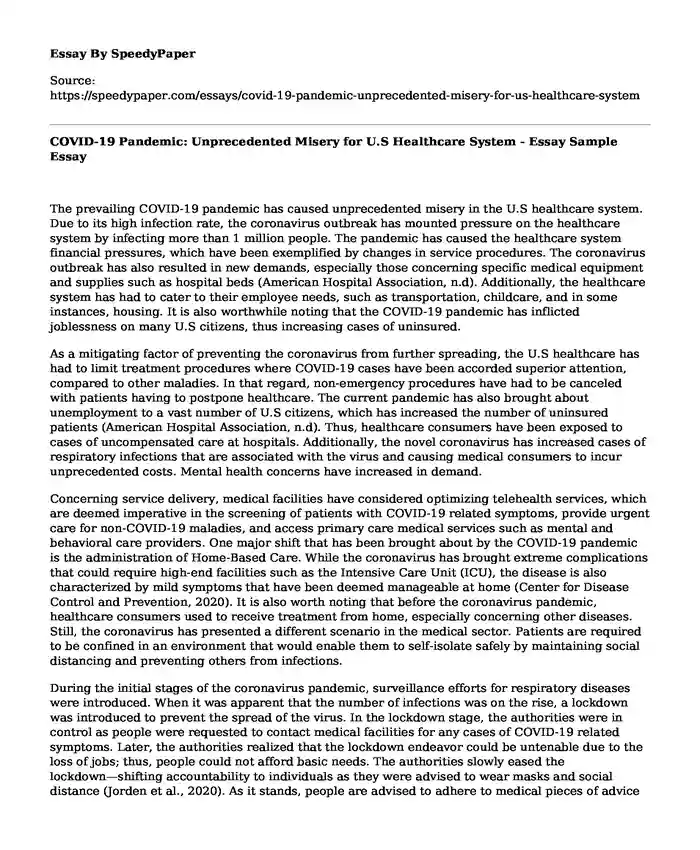The prevailing COVID-19 pandemic has caused unprecedented misery in the U.S healthcare system. Due to its high infection rate, the coronavirus outbreak has mounted pressure on the healthcare system by infecting more than 1 million people. The pandemic has caused the healthcare system financial pressures, which have been exemplified by changes in service procedures. The coronavirus outbreak has also resulted in new demands, especially those concerning specific medical equipment and supplies such as hospital beds (American Hospital Association, n.d). Additionally, the healthcare system has had to cater to their employee needs, such as transportation, childcare, and in some instances, housing. It is also worthwhile noting that the COVID-19 pandemic has inflicted joblessness on many U.S citizens, thus increasing cases of uninsured.
As a mitigating factor of preventing the coronavirus from further spreading, the U.S healthcare has had to limit treatment procedures where COVID-19 cases have been accorded superior attention, compared to other maladies. In that regard, non-emergency procedures have had to be canceled with patients having to postpone healthcare. The current pandemic has also brought about unemployment to a vast number of U.S citizens, which has increased the number of uninsured patients (American Hospital Association, n.d). Thus, healthcare consumers have been exposed to cases of uncompensated care at hospitals. Additionally, the novel coronavirus has increased cases of respiratory infections that are associated with the virus and causing medical consumers to incur unprecedented costs. Mental health concerns have increased in demand.
Concerning service delivery, medical facilities have considered optimizing telehealth services, which are deemed imperative in the screening of patients with COVID-19 related symptoms, provide urgent care for non-COVID-19 maladies, and access primary care medical services such as mental and behavioral care providers. One major shift that has been brought about by the COVID-19 pandemic is the administration of Home-Based Care. While the coronavirus has brought extreme complications that could require high-end facilities such as the Intensive Care Unit (ICU), the disease is also characterized by mild symptoms that have been deemed manageable at home (Center for Disease Control and Prevention, 2020). It is also worth noting that before the coronavirus pandemic, healthcare consumers used to receive treatment from home, especially concerning other diseases. Still, the coronavirus has presented a different scenario in the medical sector. Patients are required to be confined in an environment that would enable them to self-isolate safely by maintaining social distancing and preventing others from infections.
During the initial stages of the coronavirus pandemic, surveillance efforts for respiratory diseases were introduced. When it was apparent that the number of infections was on the rise, a lockdown was introduced to prevent the spread of the virus. In the lockdown stage, the authorities were in control as people were requested to contact medical facilities for any cases of COVID-19 related symptoms. Later, the authorities realized that the lockdown endeavor could be untenable due to the loss of jobs; thus, people could not afford basic needs. The authorities slowly eased the lockdown—shifting accountability to individuals as they were advised to wear masks and social distance (Jorden et al., 2020). As it stands, people are advised to adhere to medical pieces of advice concerning the prevention of the pandemic. Even though most accountability has previously shifted to individuals, the government has retained some control by preventing the resumption of activities in facilities such as schools. Additionally, the transport sector has not been fully resuscitated as air travel remains limited from and to specific locations.
In my opinion, the COVID-19 pandemic mitigating factors should be informed by science through constant mass testing. Key sectors of the economy should resume fully but not without constant and mass testing. The above argument is formed by the consideration of the fact that the vaccine or rather medical interventions of the virus could take longer than expected. Thus, people may continue succumbing to the disease, and even more, people may experience joblessness.
References
American Hospital Association. (n.d). Hospitals and health systems face unprecedented financial pressure due to COVID-19. https://www.aha.org/system/files/media/file/2020/05/aha-covid19-financial-impact-0520-FINAL.pdf
Center for Disease Control and Prevention. (2020, June 28). Healthcare Facilities: Managing operations during the COVID-19 pandemic. https://www.cdc.gov/coronavirus/2019-ncov/hcp/guidance-hcf.html
Jorden, MA, Rudman SL, et al. (2020). Evidence for Limited Early Spread of COVID-19 Within the United States. MMWR Morb Mortal Weekly Report 2020; 69:680–684. DOI: http://dx.doi.org/10.15585/mmwr.mm6922e1
Cite this page
COVID-19 Pandemic: Unprecedented Misery for U.S Healthcare System - Essay Sample. (2023, Nov 14). Retrieved from https://speedypaper.com/essays/covid-19-pandemic-unprecedented-misery-for-us-healthcare-system
Request Removal
If you are the original author of this essay and no longer wish to have it published on the SpeedyPaper website, please click below to request its removal:
- Introduction to Pregnancy, Free Essay Sample
- Nutrition Essay Sample: Mineral Intake Analysis and Ways to Improve
- Essay Sample: Pain Management among African American Adults with Prostate Cancer
- Essay Sample: Pharmacological Effects of Amiodarone in the Management of Arrhythmias and Nursing Implications
- Summary of the Initiative. Free Essay
- Covid-19's Global Impacts on Human Resource Management - Essay Sample
- Critical Issues Facing the U.S and their Solutions - Paper Sample
Popular categories





